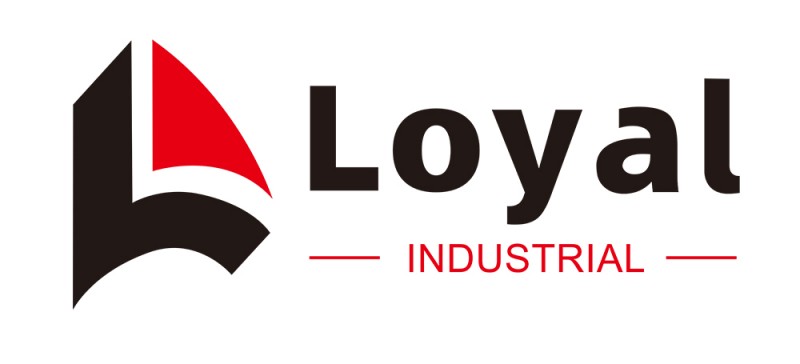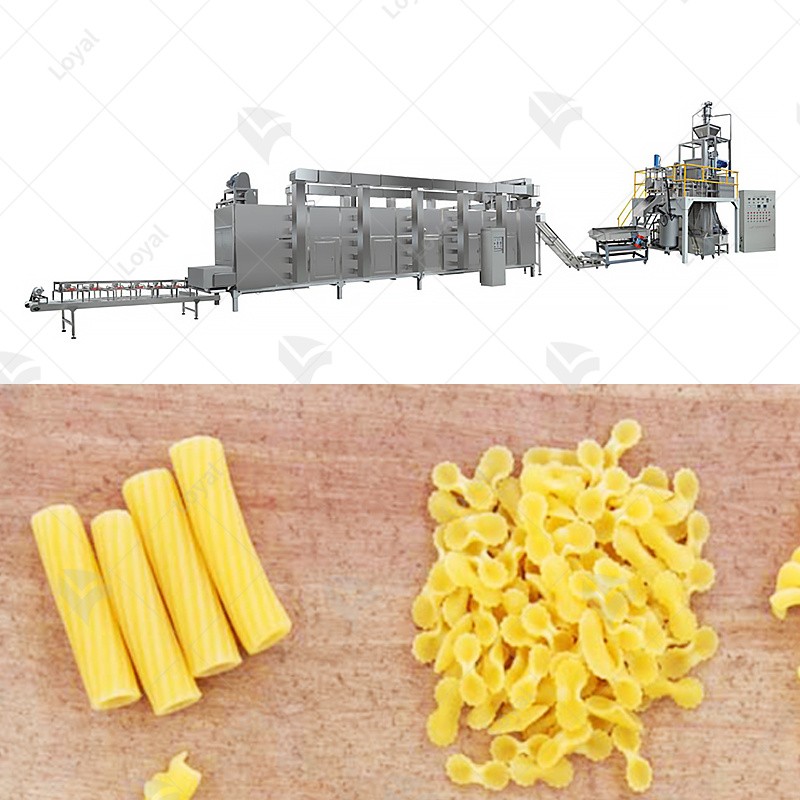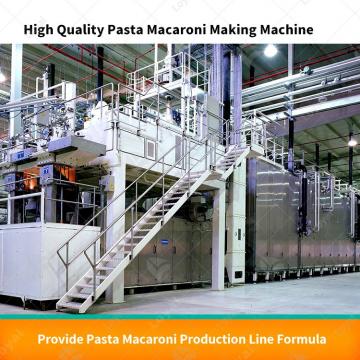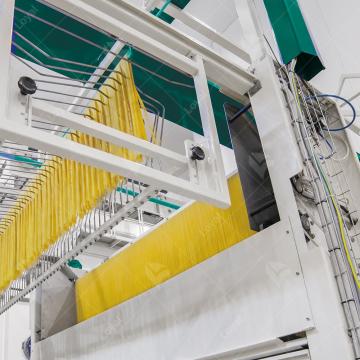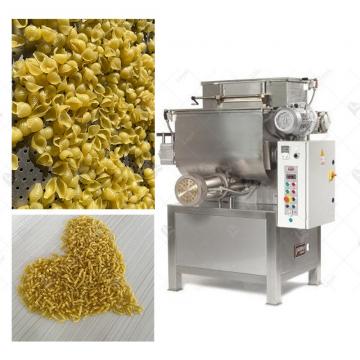Optimizing Pasta Manufacturing Process: 300kg Capacity with Vacuum Extrusion
Optimizing Pasta Manufacturing Process: 300kg Capacity with Vacuum Extrusion
Pasta manufacturing is a complex process that has evolved over the years, combining traditional craftsmanship with modern technology. The demand for high-quality pasta has driven the industry to explore innovative approaches, leading to the introduction of advanced machinery and processes.
Shandong Loyal Industrial Co., Ltd. has incorporated advanced technologies from Germany's Buhler and Italy's GEA in the production of its macaroni.The optimization of pasta manufacturing processes plays a crucial role in meeting the ever-growing demands of consumers. As competition intensifies, pasta producers are seeking ways to enhance efficiency, improve product quality, and increase overall productivity.
In this article, we delve into the optimization of pasta manufacturing, specifically focusing on the integration of 300kg capacity with vacuum extrusion. This advanced technology promises to revolutionize the pasta production landscape, offering increased capacity and efficiency.

Understanding Vacuum Extrusion in Pasta Manufacturing
Vacuum extrusion technology is a cutting-edge method used in pasta production. It involves the use of a vacuum to remove air from the pasta dough, resulting in a more homogeneous and higher-quality end product. This section explores the intricacies of this technology and its application in the pasta manufacturing process.
The benefits of vacuum extrusion are manifold, ranging from improved pasta texture to enhanced flavor retention. By understanding these advantages, pasta manufacturers can make informed decisions about incorporating vacuum extrusion into their processes.
The integration of a 300kg capacity in vacuum extrusion brings a new dimension to efficiency in pasta manufacturing. This section delves into the implications of such enhanced capacity, exploring how it contributes to faster production rates and increased overall output.
Key Components of the Optimized Process
The optimization of pasta manufacturing through vacuum extrusion and a 300kg capacity involves a comprehensive overview of the machinery and equipment. We explore the key components that make this process efficient, from the extruder itself to the control systems that govern the production.
Understanding the role of vacuum extrusion in shaping pasta is essential for manufacturers aiming to achieve consistency in product quality. This section delves into the intricate details of how vacuum extrusion contributes to the precise shaping of various pasta forms.
The optimized process has a significant impact on the quality and consistency of the final pasta product. Examining how the combination of vacuum extrusion and increased capacity influences these factors is crucial for pasta manufacturers striving to meet consumer expectations.
Operational Advantages and Efficiency Gains
The introduction of a 300kg capacity in pasta manufacturing promises improved production rates. This section explores how the enhanced capacity facilitates higher throughput, enabling manufacturers to meet market demands efficiently.

Optimizing the pasta manufacturing process extends beyond capacity – it also involves energy efficiency. Understanding how the integration of vacuum extrusion and increased capacity contributes to energy savings is essential for sustainable and cost-effective operations.
The combination of vacuum extrusion and a 300kg capacity is designed to enhance overall operational efficiency. This section delves into how the optimized process streamlines production workflows, minimizes downtime, and improves the resource utilization of pasta manufacturers.
Implementation Guidelines and Best Practices
Efficient implementation is key to realizing the benefits of the optimized pasta manufacturing process. This section provides step-by-step guidelines for seamlessly integrating a 300kg capacity with vacuum extrusion. Manufacturers can follow these guidelines to ensure a smooth transition to the enhanced production process.
Maintaining the optimal performance of the integrated system is essential for sustained efficiency. Here, we outline maintenance protocols specific to the machinery involved in the pasta manufacturing process. Regular maintenance ensures longevity, minimizes downtime, and maximizes the return on investment.
Despite the advancements, challenges may arise during the optimization of the pasta manufacturing process. This section identifies and provides solutions for common challenges manufacturers may encounter when implementing vacuum extrusion with a 300kg capacity. Preparedness for these challenges is vital for a successful optimization journey.
Case Studies: Successful Application of Vacuum Extrusion
Examining real-world examples of pasta manufacturers, including renowned brands like Barilla, De Cecco, Creamette, San Giorgio, and Great Value, provides insights into their successful application of vacuum extrusion technology with increased capacity. These case studies showcase the practical implications and benefits of the optimized process.
Quantifiable results in terms of production output and quality further substantiate the success of the optimized pasta manufacturing process. Analyzing data from the case studies highlights the tangible improvements achieved by incorporating vacuum extrusion with a 300kg capacity.
Industry experts, including professionals from the pasta manufacturing sector and machinery specialists, offer testimonials regarding the application of vacuum extrusion with increased capacity. Their insights provide authoritative perspectives on the benefits and advancements in the optimized process.

Future Trends in Pasta Manufacturing Technology
The future of pasta manufacturing technology holds exciting possibilities. This section explores innovations and upcoming developments in the field. From advancements in vacuum extrusion to novel materials and smart technologies, staying informed about these trends is crucial for manufacturers aiming to stay at the forefront of the industry.
The emphasis on sustainability in the food industry is influencing pasta manufacturing. Here, we delve into how the optimized process, including vacuum extrusion with a 300kg capacity, aligns with sustainable practices. The adoption of eco-friendly materials and energy-efficient processes contributes to a more environmentally conscious pasta production.
The integration of advanced technologies, such as vacuum extrusion with increased capacity, is expected to drive market growth in the pasta manufacturing sector. This section explores the anticipated opportunities for manufacturers to expand their product lines, cater to diverse consumer preferences, and explore emerging markets.
Conclusion
In conclusion, the optimization of the pasta manufacturing process through vacuum extrusion with a 300kg capacity marks a significant leap forward for the industry. This section recaps the key advancements and benefits discussed throughout the article.
Encouraging the broader adoption of advanced technologies, such as vacuum extrusion, is crucial for the continued evolution of the pasta manufacturing sector. This section emphasizes the importance of industry collaboration and knowledge sharing to drive innovation.
As pasta manufacturers embrace optimized processes, including vacuum extrusion with a 300kg capacity, the industry is poised for a transformative journey. The final thoughts reflect on the evolution of pasta manufacturing, highlighting the significance of embracing technological advancements to meet the demands of a dynamic market.
FAQs: Common Questions about Pasta Manufacturing Process
1.What is the significance of vacuum extrusion in pasta manufacturing?
Vacuum extrusion plays a crucial role in pasta manufacturing by removing air from the dough, resulting in a more homogeneous and higher-quality end product. This technology enhances the texture and flavor of pasta, contributing to a superior consumer experience.
2. How does a 300kg capacity impact pasta production rates?
A 300kg capacity in pasta manufacturing significantly improves production rates. The enhanced capacity allows for higher throughput, enabling manufacturers to meet market demands more efficiently and ensuring a steady supply of pasta products.
3.What are the maintenance protocols for the integrated system?
Maintaining the optimal performance of the integrated system involves regular maintenance. This includes routine inspections, cleaning, and lubrication of key components. Following specific maintenance protocols ensures sustained performance, minimizes downtime, and extends the lifespan of the machinery.
4. Can vacuum extrusion with increased capacity address common challenges in pasta manufacturing?
Yes, vacuum extrusion with a 300kg capacity is designed to address common challenges in pasta manufacturing. From optimizing shaping processes to improving efficiency, this integrated system tackles challenges such as consistency, energy efficiency, and overall operational efficiency.
5. How do real-world examples and case studies validate the optimization process?
Real-world examples from prominent pasta manufacturers like Barilla, De Cecco, Creamette, San Giorgio, and Great Value serve as validations of the optimization process. Case studies provide quantifiable results, showcasing improvements in production output and product quality, along with testimonials from industry experts.
